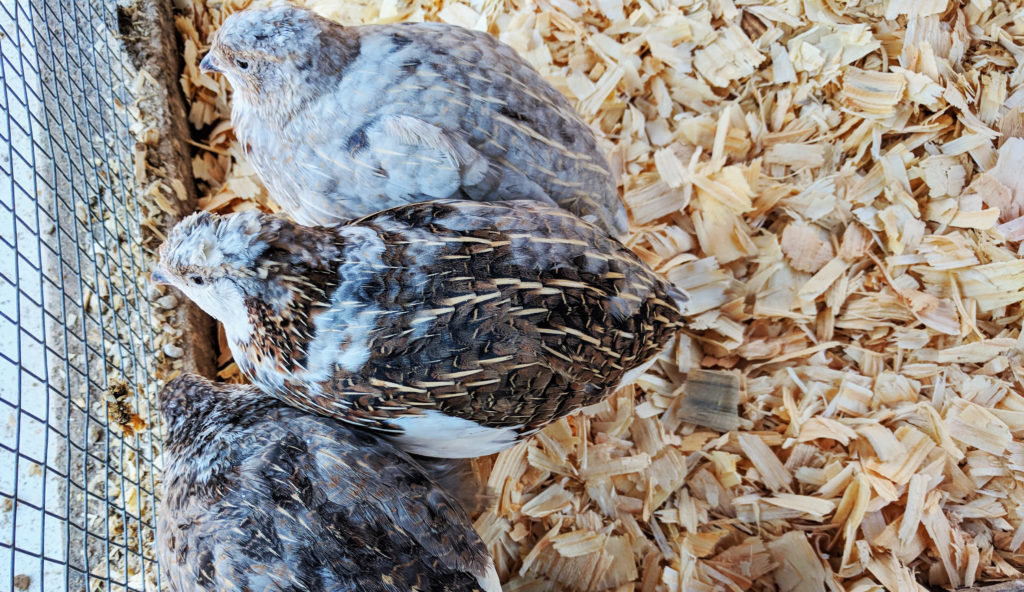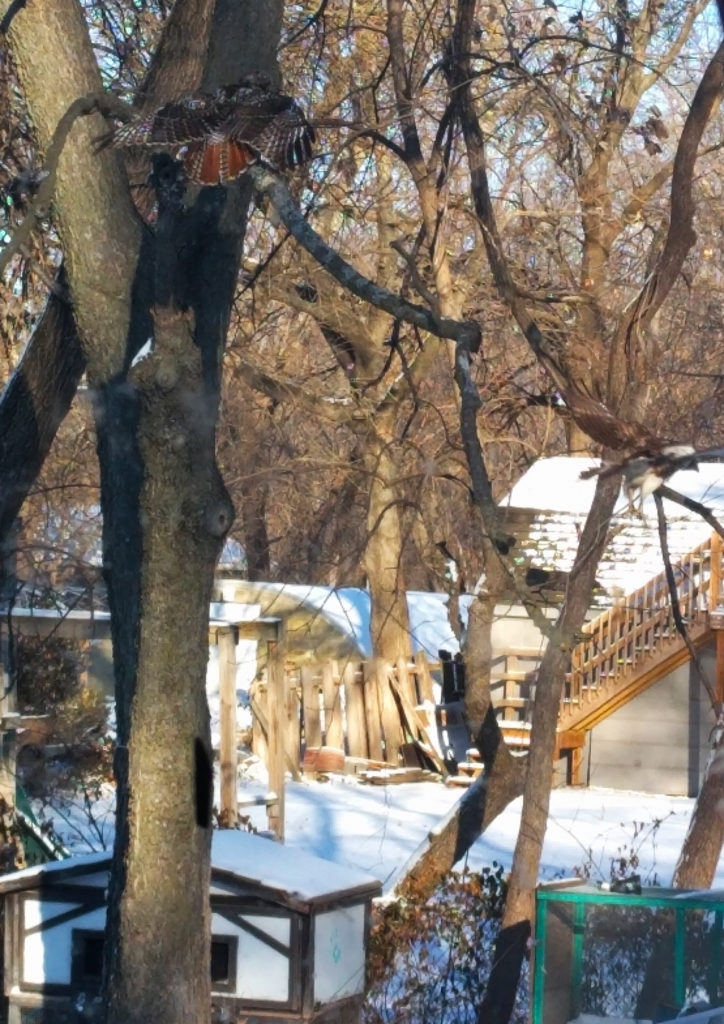Learn tips and tricks for safely housing these marvelous birds from quail expert and owner, Kelly Bohling. (Unless otherwise noted, all photos by author.)
Quail Are Easy to House
Raising Coturnix quail—also known as Japanese quail—is an approachable endeavor, made easier by the low maintenance habits of the birds and their hardiness against disease and climate shifts. One area of quail husbandry that can prove challenging, however, is housing them. Many coops available commercially are made with chickens in mind; construction and design elements that are suited for chickens become weaknesses when used for quail. Hawks, raccoons, and foxes are just a few of the natural predators that can pose a threat to domestic fowl, but they don’t deserve all the blame. Rather than punish wildlife for their instinctual behaviors, we must take responsibility for providing a safe, secure environment for our animals. A few simple coop modifications will provide your quail with a safe home that also accommodates their natural preferences.
Ground Coop or Raised Coop?
The Nature of Quail… and Your Back
Quail are ground birds by nature. They won’t roost in trees, but rather find shelter in thickets and bushes, and scratch about in forest detritus for insect snacks. When Japanese quail are kept domestically on raised wire-floored coops, they rarely show broody tendencies; sitting on and hatching their own eggs is very unusual behavior for quail. However, many quail keepers notice that placing their fowl in ground coops, or even solid-bottomed raised coops, results in frequent broodiness among hens. Many attribute this broody behavior to the similarities between solid-floored or ground coops and the quail’s natural habitat.

Female quail on the ground. Getty images.
Deciding on the type of coop will depend on what you think is right for your quail and what’s best suited for the space you have available. You can place a ground coop under some tall bushes or roof extension. Or, you can avoid the bending necessary to deal with a low coop and chose a raised coop instead. There are pros and cons to each set-up, for both you and your birds.
Ground Coops
A ground coop arguably provides the environment closest to a quail’s natural habitat, but there are a few factors to consider for the safety and health of the birds. Good drainage and even terrain are important when choosing a ground coop location. If you place the coop under a roof or patio overhang where there might be water drainage, make sure there isn’t standing water or run-off on the bottom of the coop. Check that the entire perimeter of the coop bottom makes contact with the ground, leaving no gaps for clever predators to crawl underneath. If the grass or groundcover fails to thrive because of bird foot traffic or excessive shade, add pine shavings or mulch, making it so the birds aren’t on bare dirt. You’ll need access to all corners of the coop for ease of cleaning, and also because quail will lay their eggs anywhere.
Most commercial coops are designed to rest open-bottomed on the ground, which can be suitable for quail keeping. However, many predators will dig underneath a coop. In just a few minutes, a raccoon can dig a trench large enough to reach in and grab a couple of birds. Consider burying some type of barrier around the coop. One possibility is to use 12-inch-square concrete pavers, buried vertically around the coop. Dig a 6-inch deep trench around the coop and bury the pavers. This will leave 4-6 inches (after the ground settles) above the bottom of the coop wire, making it much harder for predators to access the coop.
You can also bury 1/2-inch-square hardware cloth around the bottom of the coop, fastening it to the coop with staples or wood trim for added security. Hardware cloth works better than chicken wire for quail coops, as it’s more durable and has smaller openings. Also, 1/2-inch hardware cloth can be stapled to the floor of the coop as an additional barrier against burrowing predators, although droppings tend to cake in the wire gaps and requires more frequent coop cleaning. However, it’s still not secure enough as a singular defensive layer.
Elevated Coop
An elevated coop protects against the danger of predators digging in or burrowing from underneath. The coop can be elevated on pavers, railroad ties, or a structured frame of 2x4s. A wire-floored, elevated coop also provides adequate drainage and a clean environment, as the droppings readily fall through. Half-inch-square hardware cloth makes a suitable floor, and is still a small enough mesh for quail feet to walk on comfortably. Provide some off-wire locations as well, such as a nesting box with pine shavings, so that the quail can rest their feet.

Elevated coop with door latches and solid floor.
Hardware Cloth Flooring
Unfortunately, motivated predators can still attack and procure quail through ½-inch hardware cloth. When we kept our quail in an elevated, wire-floored coop, raccoons and hawks sat underneath, intimidating and lunging at the birds from below. I’ve lost a couple of birds to predators through 1/2-inch hardware cloth floors, as hard as it is to imagine. I’ve found that it’s best to wrap the bottom structure with a “skirting” of chicken wire or other fencing material. The challenge is to provide this security while still having access to clean out accumulating droppings beneath the coop. You can put wheels on the coop or handles on each end to help move the coop and clean underneath.

Half-Inch Hardware cloth walls
Quarter-inch hardware cloth can also be used for a floor and is ideal for security purposes, making additional skirting unnecessary. It’s also more comfortable for your quail long term. But the small mesh leads to accumulation of droppings on the floor itself, so it comes with additional cleaning requirements.
Solid Flooring
A solid-floored, elevated coop provides security against burrowing predators in addition to preventing attacks through a wire floor. However, it comes with drainage and cleanliness challenges. After trying many variations of each of these types of coops, I built a solid-floored, elevated coop for my own quail. I chose a rigid plastic panel for the flooring. Since it’s waterproof, it doesn’t become saturated with moisture and ammonia, and is easy to rinse off. I drilled a few small holes through the floor for better drainage, and provided a thick layer of pine shavings on top so the quail can stay clean and not slip on the floor—a slippery floor can cause spraddle or splay leg. Avoid cedar shavings, as the strong odor can cause respiratory issues. Quail enjoy snuggling into pine shavings and will even burrow out a small area for a clutch of eggs. I’ve observed a couple of hens sitting on these clutches, but they haven’t successfully hatched any eggs yet.

Quail on pine bedding.
The main drawback with the solid-floored coop is the frequency that the substrate must be changed. Old shavings that have become saturated with droppings and discarded food result in “toe balls” (clumps that stick to quail feet), and also attract flies and other pests. Luckily, pine shavings are cheap enough to change often, and you can compost old shavings. An old dust pan makes a great cleaning scoop, and cuts down time for this chore.
Over the Top
No matter which coop and flooring you choose, there are additional considerations that apply to every quail shelter. Quail should have access to a cool, shady location at all times. Placing the coop beneath a few mature trees will provide shade and also help protect birds from wind, rain, and snow. Roofing materials should be waterproof, and a few inches of roof overhang all around the coop will help keep it dry and shaded.

Sloped Roof
Shingles or galvanized flashing (available in rolls or wide sheets) are my personal preferences for roofing materials, and I like angled roof lines to encourage rain runoff and prevent rotting leaves from accumulating. Walls screened with 1/2-inch hardware cloth should be sturdy enough, especially in elevated coops in locations where low branches have been removed to deter loitering visitors.
Nesting Box
Many coops come with a nesting box. Unlike chickens, who prefer to lay eggs in a nesting box, quail may, or may not lay eggs there, But they will enjoy the snug space, especially in the winter. I put a heat lamp in the nesting box during the winter to give them a place to warm up, and to keep at least one waterer thawed. These nesting boxes usually have a hinged door that opens upwards, and while this is convenient for cleaning and access, it can also provide access for predators smart enough to pry it open.
Startling Behavior
One major fault of quail is their tendency to startle easily. When a quail is scared, or perceives incoming danger, it’ll fly straight up as fast as possible. Unfortunately, it’ll usually fly straight into the ceiling of the coop, resulting in a serious head injury at best, and broken neck at worst. Quail don’t mind calm, quiet visits, but if small children or pets are running by, they’ll likely startle. Place your coop in a low-traffic area, away from vehicular, animal, and people traffic.
Taller coops with higher ceilings may help decrease injuries from startling, and I’ve even considered padding the ceilings of my own coop. In the end, the birds will be better off if the surprises can be limited and their environment kept quiet.
Predator Prevention
Despite having a hasp and lock on my nesting box door, I once had a raccoon muscle its way in through the nesting box lid. I now put a few pavers or bricks on top of the nesting box door, in addition to securing it with a hasp and lock, and have had no further issues. Even though coops are usually equipped with hasps on all doors, adding a small padlock on each never hurts.

Two hawks eyeing our coops.
We have had a several species of hawk (ranging from the small Cooper’s hawk to the much larger Red-Tailed hawk) visit our backyard and eye our quail. These hawks perch on low branches close to the coop or even land on the narrow wooden edge of the coop, beating their wings against the side until the quail startle. I’ve had fewer problems after putting up plywood or a shade cloth that makes the quail harder to see. Block the hawk’s line of sight and they lose interest.
Keeping quail and successfully housing them is a learning process, but a rewarding one. Build the coop stronger and more protected than you think is necessary as predators are hungry and clever. A few security measures will keep your quail calmer and safer.
Kelly Bohling is a native of Lawrence, Kansas. She works as a classical violinist, but in between gigs and lessons she’s out in the garden or spending time with her animals, including quail and French Angora rabbits. Kelly also spins the Angora fiber from her rabbits into yarn for knitting, which can be found in her Etsy shop, ThreeRabbitYarns. She enjoys finding ways that her animals and garden can benefit each other for a more sustainable urban homestead. You can follow her on Instagram @threerabbityarns.












